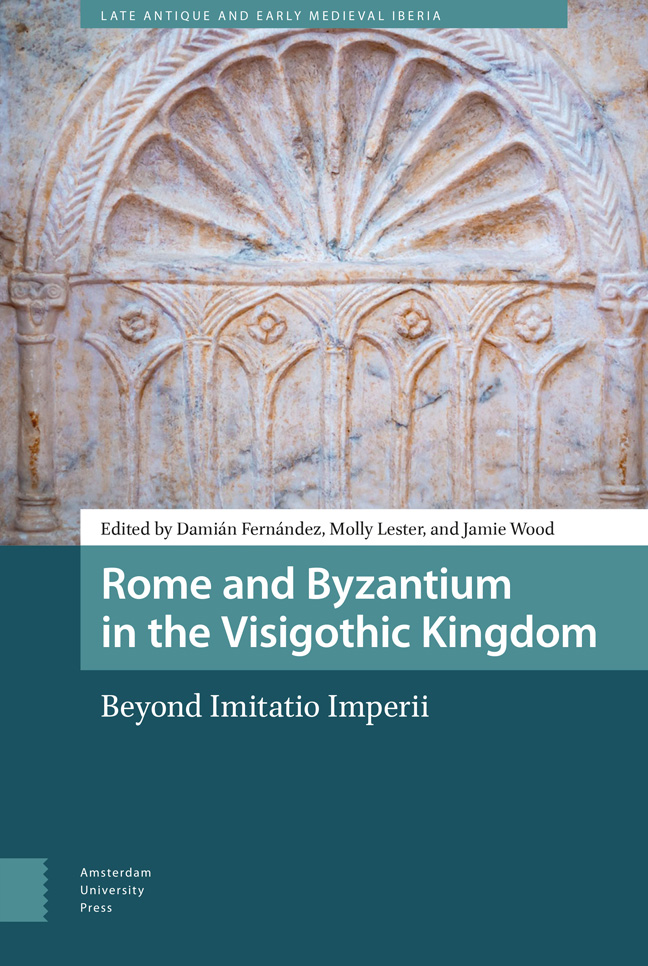Book contents
- Frontmatter
- Contents
- List of Figures and Tables
- Abbreviations
- Acknowledgements
- Maps
- Introduction
- 1 Visigothic Spain and Byzantium: The Story of a Special (Historiographical) Relationship
- 2 The Development of the Visigothic Court in the Hagiography of the Fifth and Sixth Centuries
- 3 Experiments in Visigothic Rulership: Minting and Monetary Reforms under Alaric II
- 4 A Comparison of Roman and Visigothic Approaches to Exile
- 5 The Roman Jewel in the Visigothic Crown: A Reassessment of the Royal Votive Crowns of the Guarrazar Treasure
- 6 Capitalhood in the Visigothic Kingdom
- 7 Making Rite Choices: Roman and Eastern Liturgies in Early Medieval Iberia
- 8 Ethnicity and Imitatio in Isidore of Seville
- 9 Re-imagining Roman Persecution in the Visigothic Passions
- 10 Romanness in Visigothic Hagiography
- 11 Empire and the Politics of Faction: Mérida and Toledo Revisited
- 12 The Agents and Mechanics of Connectivity: The Mediterranean World and the Cities of the Guadiana Valley in the Sixth Century
- 13 Staying Roman after 711?
- Index
2 - The Development of the Visigothic Court in the Hagiography of the Fifth and Sixth Centuries
Published online by Cambridge University Press: 20 February 2024
- Frontmatter
- Contents
- List of Figures and Tables
- Abbreviations
- Acknowledgements
- Maps
- Introduction
- 1 Visigothic Spain and Byzantium: The Story of a Special (Historiographical) Relationship
- 2 The Development of the Visigothic Court in the Hagiography of the Fifth and Sixth Centuries
- 3 Experiments in Visigothic Rulership: Minting and Monetary Reforms under Alaric II
- 4 A Comparison of Roman and Visigothic Approaches to Exile
- 5 The Roman Jewel in the Visigothic Crown: A Reassessment of the Royal Votive Crowns of the Guarrazar Treasure
- 6 Capitalhood in the Visigothic Kingdom
- 7 Making Rite Choices: Roman and Eastern Liturgies in Early Medieval Iberia
- 8 Ethnicity and Imitatio in Isidore of Seville
- 9 Re-imagining Roman Persecution in the Visigothic Passions
- 10 Romanness in Visigothic Hagiography
- 11 Empire and the Politics of Faction: Mérida and Toledo Revisited
- 12 The Agents and Mechanics of Connectivity: The Mediterranean World and the Cities of the Guadiana Valley in the Sixth Century
- 13 Staying Roman after 711?
- Index
Summary
Abstract
Discussions of the Visigothic court have tended to concentrate on the reforms brought in by Leovigild. For the previous century and a half, we do have some evidence in the letters of Sidonius Apollinaris, and in various hagiographic accounts, notably the Lives of Orientius of Auch, Bibianus of Saintes, and Epiphanius of Pavia. These highlight the importance of formal dining (the convivium), and they also imply that royal banquets followed the traditions of aristocratic dining, rather than any elaborate ceremonial. The archaeology of late Roman villas gives us some insight into the reality of the convivium.
Keywords: convivium; Sidonius Apollinaris; Euric; Theodoric II; Vita Orientii; Vita Bibiani
An obvious point of departure when considering Byzantium and the Visigothic kingdom of Toulouse is the reign of Leovigild (568–586). In Edward Thompson's words, Leovigild ‘dressed himself “in royal raiment and seated himself upon a throne”. Hitherto the kings had worn much the same dress as their subjects, and had been accessible to all, like the old Germanic chieftains. But Leovigild surrounded the throne with something of Byzantine pomp, though the details of what he did are not recorded.’ The reign of Leovigild, however, will be my end point. I am interested in what the Visigothic court was like before Leovigild's reforms. This will take us to Toulouse rather than Toledo, and to the courts of western emperors rather than Byzantium. It will not take us to the dress of ‘old Germanic chieftains’.
Our image of the Visigothic court in the fifth century is largely derived from Sidonius's accounts of the courts of Theodoric II and Euric. Certainly this is the most vivid material. But there are several small anecdotes and snippets of information that add to his. For the reign of Athaulf there is Orosius's story of the Narbonnensian familiarissimus of the king, in which we learn that the king decided not to overthrow the empire, but rather to support it with Gothic arms. The story is clearly symbolic, and we do not need to believe the detail, but there was a Roman coterie surrounding Athaulf, Galla Placidia, and Attalus, including the senator Paulinus of Pella, although his view of Athaulf's reign is very much less happy.
- Type
- Chapter
- Information
- Rome and Byzantium in the Visigothic KingdomBeyond Imitatio Imperii, pp. 53 - 72Publisher: Amsterdam University PressPrint publication year: 2023

